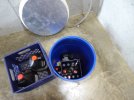Maybe I can shed some light on this.
Double base powders, nitro cellulose and nitroglycerin, are stable for at least 100 years. The original batch of Bullseye is stored under water and a sample tested every 25 years. Good to go for our life times.
Single based powders are a difference animal. Wood fibers, linters, are soaked in nitric acid for several weeks. When rinsed, they are ready to burn (gun cotton), much too fast for gun powder. They are then processed to shape added material (Vaseline to make cordite) to control flame spread and burning rate. They will decompose very easily and give off flammable vapors. DuPont produced IMR 4320 from the late 1960's was noted for decomposing in just a couple of years in the one pound can. IMR continued to sell this stuff into the 1990's, never wasting a pound of this crap.
So, we have a flammable material that is off gassing flammable vapors inside a sealed can and the pressure is rising. The bigger the container, the higher the risk of heat of decomposition and rising pressure making it ignite. Second, as the vapors leak out of the container, they only have to be within their flammable range for any spark to ignite. Tripping relay, automatic fan turning on, heater starting or any electric switch. Another source is that if the nitric acid is not entirely washed off, it will combine with an paper, wood or organic material. I have been on multiple semi-trailer fires where nitric acid leaked onto the wood floor and started fires while driving down the interstate.
RB's NV depot fire is a classic of unknown conditions stored single based powder stored for 50 plus years in a bunker so heat could not escape. Same thing happened at the Umatilla Army Depot in Hermiston, OR.
Leaking nitroglycerin is not a common problem anymore, as the last of that type was used in WW2. Basically, it is like dynamite, nitroglycerin absorbed into diatomaceous earth. TNT is cheaper to make, weights less and is safer to handle. By 1968, the US Army had used up all of the WW2 dynamite and TNT and were using C4 for its engineering work.
HTH's

